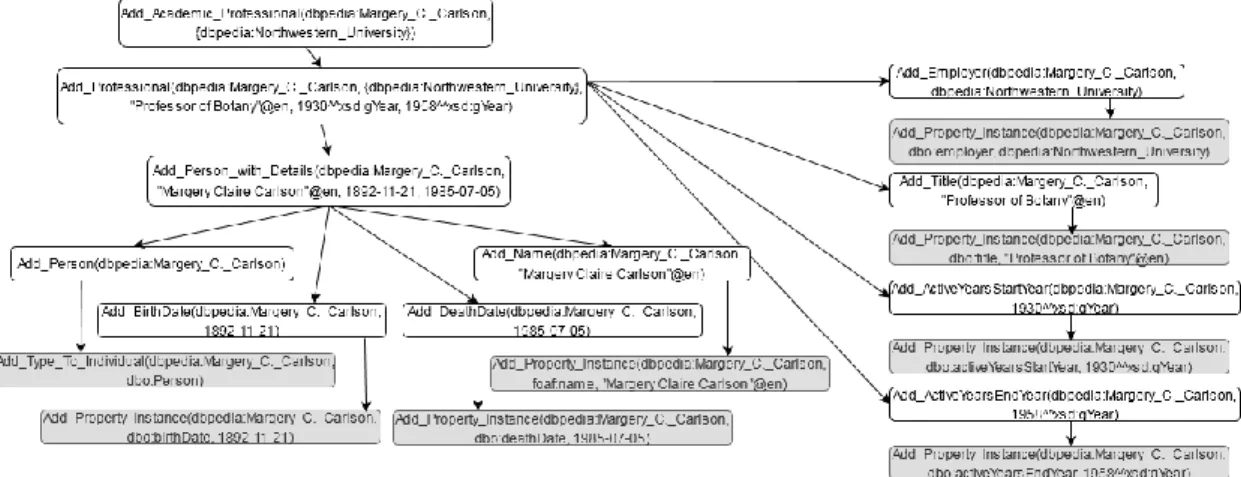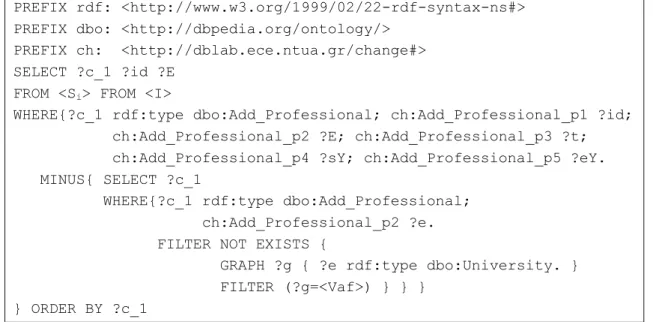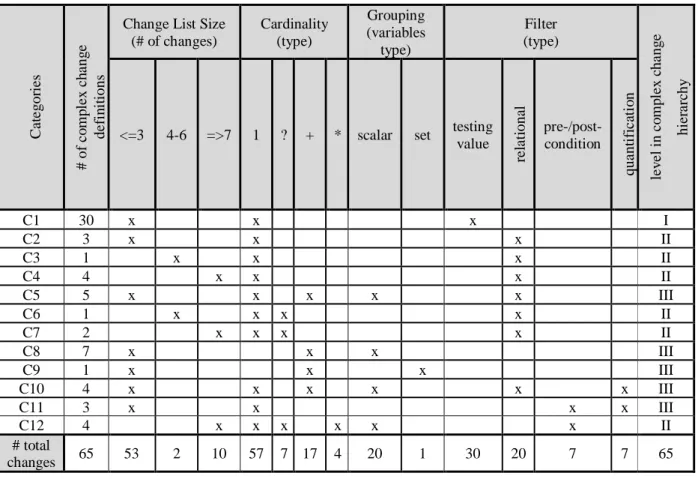Specifically, we formally defined evo-path, an XPath extension to perform time-aware and change-aware queries on the evo-graph. The space efficiency of evoXML is investigated for different configurations, as well as the performance of the reduction process, the process of generating a snapshot team during a specific time instance from the evo-graph.
Introduction
Motivation
Particularly in the case of a special language for defining changes, it should be explored how these change definitions can be used to track relevant changes between versions. Therefore, suitable algorithms for detecting change agents as first-class citizens among dataset versions should be explored.
Contributions
We present in detail the detection algorithm as well as the correctness of the proposed implementation with respect to the language semantics. It is worth noting that changes in evo-graph are modeled using simple (there named as basic) and complex changes.
Thesis Outline
We also evaluated the performance of the reduction process, the process of generating a snapshot team during a specific time instance from the evo-graph, with respect to the size of the evoXML file. The evaluation performed indicated which factors characterize the data that affect the evoXML size and the reduction process.
Related Work
Modeling and Detecting Changes in Knowledge Bases
- Machine-readable changes
- Human-readable changes
Together with the version log, the CDL provides the foundation of the change tracking approach. A set of desirable features related to the detection and application semantics of the language of changes is presented.
Modeling and Querying Evolution in Semistructured Data
- Version-based approaches
- Temporal approaches
- Other approaches
Furthermore, two alternative approaches to the physical implementation of the model are presented, so that data represented in the model is translated into XML documents. In the second part of the paper, an approach for summarizing and indexing temporary XML documents is presented.
Defining and Detecting Complex Changes on RDF(S) Knowledge Bases
Introduction
Modeling complex changes as custom also makes their definitions reusable, further easing the process of defining new changes. However, complex changes may share common parts without being defined as nested, but have overlaps, providing a complementary interpretation of evolution. In this direction, there is a need for a dedicated language to define complex changes and a relevant detection algorithm to facilitate the precise modeling and reusability of changes.
However, the relationships and dependencies between complex changes are not supported by any of the existing approaches. Furthermore, we propose a dedicated language based on change semantics for defining complex changes and a corresponding detection algorithm.
Motivating Example
The Add_Title, Add_ActiveYearsStartYear, and Add_ActiveYearsEndYear change instances represent secondary changes that can occur when a professional is added. Instead of assuming a two-level representation of changes via simple and complex changes would balance the needs. On the other hand, complex changes offer another layer of custom changes that group other changes into logical units.
A complex change can be uniquely identified by a name, described by a set of parameters, and defined as a pattern consisting of simple changes, other already defined complex changes, and constraints that guide which change instances are grouped into so as to form a new complex change. example. Finally, the representation of detected complex change instances as RDF data allows searching for relationships and dependencies between changes via SPARQL [31] and demonstrating the change hierarchy by any graphical visualization tool for RDF data (Antoniazzi and Viola.

Simple and Complex changes on RDF(S) Knowledge Bases
Note that definitions 1 and 2 actually define a class of simple and complex changes respectively, and not the concrete changes. The terms simple change and complex change will be used as an abbreviation for any concrete simple/complex change in the class concerned. A complex change instance 𝑐𝑖 = (𝑛, 𝑉) is detected if: (1) for all changes in 𝐷 instances are detected between 𝑉𝑏𝑒𝑓 and 𝑉𝑎𝑓, forming 𝐷𝑖 so that constraints in 𝐹𝐶 are verified on 𝐷𝑖, 𝑉 𝑏𝑒𝑓 and 𝑉𝑎𝑓, (2 ) bonds in 𝐹𝐵 are applied to 𝐷𝑖 formation 𝑉, and (3) 𝐷𝑖 is maximal.
Constraint property is transitive: if complex change instance 𝑐𝑖 contains complex change instance 𝑐𝑗 and 𝑐𝑗 in turn contains change instance, then it also holds that 𝑐𝑖 contains 𝑐𝑘. They overlap if they both contain at least one common simple or complex change instance.
A Language for Defining Complex Changes
- Syntax
- Semantics
- Baseline Algebra and Semantics
- Extended Algebra and Semantics
- Illustrative Examples
Thus, a complex change can be defined as tolerant of partially implemented changes at lower levels in the change hierarchy. Thus, a complex change can be defined as flexible and tolerant of partially implemented minor changes. In this way, it is defined that the identifier on the right, which represents a complex change parameter, is equal to the identifier on the left, which represents the parameter value of a change in the change list.
The body of a complex change definition forms a change pattern expression (or a change pattern), while the head indicates how to construct a complex change instance. No binding is defined, as it is derived by repeating the complex change parameter as a parameter on the change in change list.
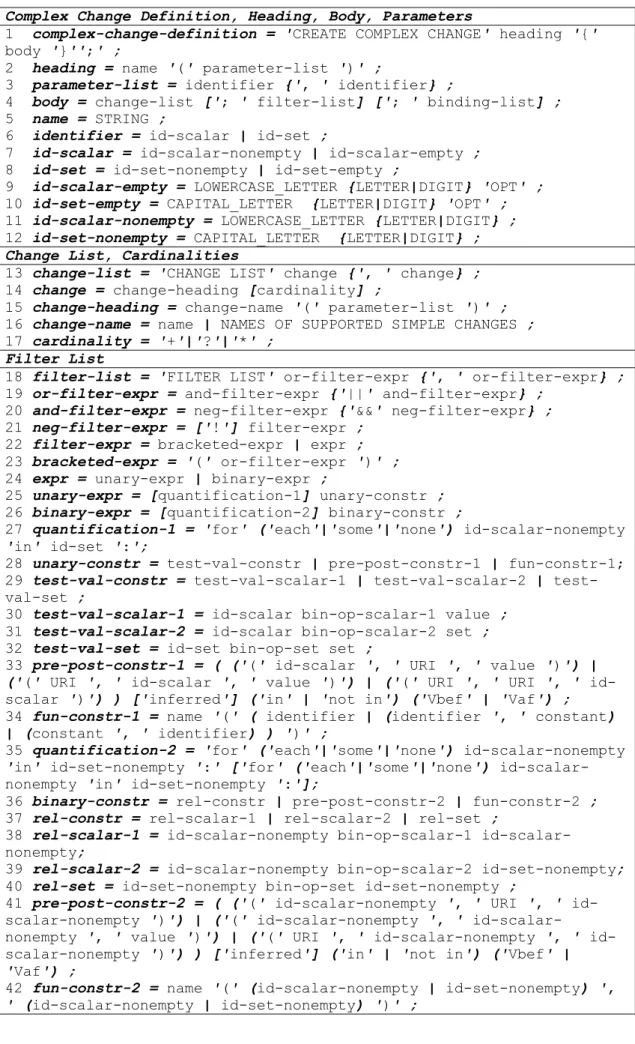
Complex Change Detection
- Algorithm
- RDF(S) Change Representation
- SPARQL Query Generation
- Change Instance Generation
- Complex Change Detection Correctness
As for the first step, assume a complex change 𝑐 whose definition is based on a set of complex changes (𝐷𝐶. The result set lines that share common values in the group variables are used to generate a new complex change instance. Input: ' n result set rs of a SPARQL query of complex change 𝑐, the set of grouping variables 𝑃 of 𝑐.
The corresponding instance of the complex change (𝑐𝑖) in the result (𝐼𝑐) should be updated (line 15) via the function 𝑢𝑝𝑑𝑎𝑡𝑒𝐼𝑐. If there is already a complex change instance (𝑐𝑖) with the same grouping variable values (𝑐𝑢𝑟𝑟𝑃𝑣𝑎𝑙𝑠) in the result (𝐼𝑐), then the combined data (𝑔𝑖) must be included in it (lines 24-28).
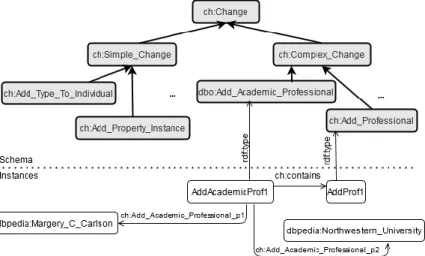
Evaluation
- Qualitative Evaluation
- Experimental Evaluation
- Implementation, datasets and settings
- Language expressiveness
- Detection performance
- Results summary
The number of complex change definitions per category is presented, as well as per language feature. Given an increasing dataset size, the number of detected complex change instances also increases. It also presents the total number of detected complex change instances and the total number of distinct triples.
It also presents the total number of triples added and complex change instances detected in each category. Overall, the time to generate and load instances increases as the number of detected complex change instances also increases.
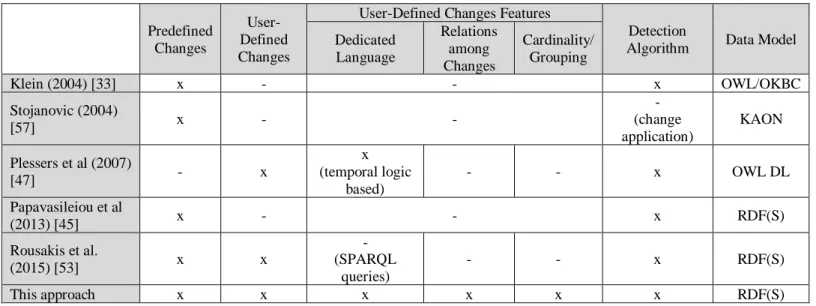
Querying Data Versions and Change Structures on XML Data
Introduction
In addition, in previous work (Stavrakas and Papastefanatos) an XML representation for evo-graph, called evoXML, has been proposed. XQuery [52] is the standard query language for querying XML data based on XPath [51], a language based on path expressions to navigate through an XML document and select data nodes Building on previous work, we formally define evo-path, an XPath (Robie, Dyck, and Spiegel extension to perform time-aware and change-aware queries on evograph.
Evo-path makes it possible to query both data history and change structure in a unified way, using changes to retrieve and correlate data that are otherwise irrelevant to each other. We also implemented and experimentally evaluated the basic concepts of evo-graph in the C2D framework, using XML technologies.
Motivating Example
Preliminaries: Modeling Data Versions and Changes on Evo-Graph
Evo-graph can then be reduced to a snap model that holds for a specified time instance through the reduction process [55]. The reduction of the evo-graph for T=start (i.e. 0) results in the snap model of the leftmost image in figure 4, while for T=now in the snap model of the rightmost image in figure 4. The above definitions describe the effect of each snap change to the current snap model.
The evo graph data root and change root are mapped to the elements evo:DataRoot and evo:ChangeRoot respectively. Each element is labeled with the label of the respective node and has an attribute evo:id whose value is the respective node id in the evo graph.
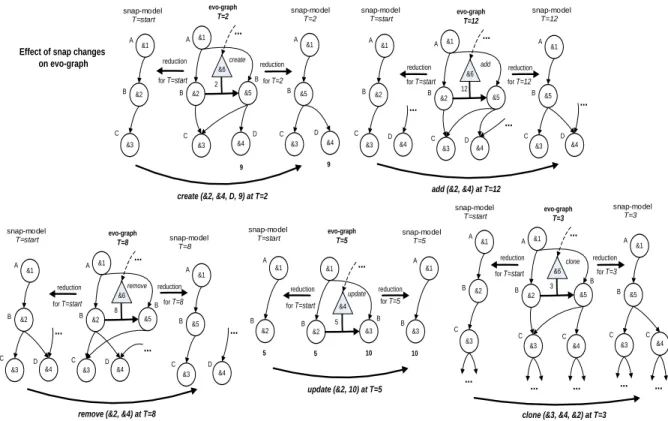
EvoPath Query Language
- Syntax
- Example Queries
- Semantics
- Implementation
In Example 5, evo-before() and evo-after() check whether the data node in the context is valid before and. In Example 6, evo-before() and evo-after() check whether the change node in the context represents a change before or after the data node in the context applies to. In evo-path, the meaning of a datapath expression is a sequence of (datanode, interval) pairs such that the datanode in this interval was continuously at the end of the matching datapath.
In evo-path, the meaning of a change-path expression is a sequence of (change-node, instance, data-node-before, data-node-after) tuples such that the change node is at the end of a matching change path at the specific instance and it refers to data-node-before and data-node-after the change. The instance is the timestamp (transaction time) when the change was applied to data-node-before, leading to data-node-after.
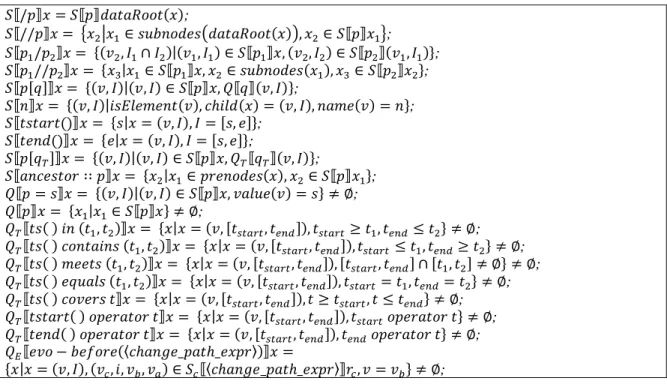
Evaluating the C2D Framework
- The C2D Framework
- Evaluation
- Experimental Setting
- Results
We also examined the efficiency of the reduction process with respect to the size of the evoXML file. In addition, we examined the performance of the reduction procedure for the current snapshot (T=now) and the initial snapshot (T=0). Intuitively, we expect the size of evoXML to depend on the number of snap changes made.
In general, the evoXML size depends almost linearly on the number of snap changes applied, since the average fanout is constant. In addition, the rate of increase of the evoXML size is proportional to the average blowout of its elements.
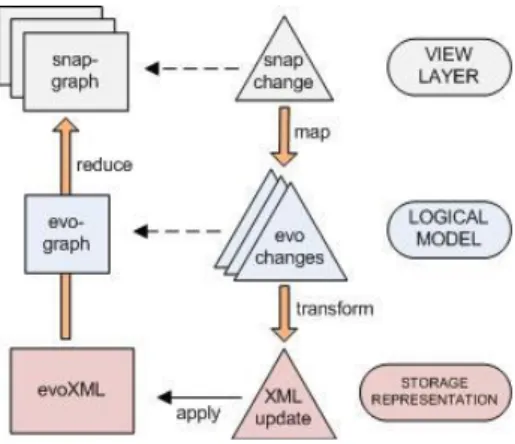
Conclusions and Future Work
Thesis Conclusions
It is evaluated whether the proposed structures are suitable for expressing useful changes and how complex changes facilitate the user's understanding and analysis of evolution. Also, the response time of the discovery process is examined with respect to the increasing size of the data set. In general, the proposed approach offers expressiveness and flexibility in terms of interpretation of evolution, as complex changes provide additional information for the interpretation of past data, enable the interpretation of evolution in several ways, while capturing relationships between complex changes is an additional feature that enriches the expressiveness of complex changes. .
Evo-path makes it possible to query both data history and change structure in a unified way, supporting temporal, evolution and causality queries. We presented the syntax of evo-path, we defined the formal semantics of evo-path, and we presented an implementation based on a formal translation of evo-path into equivalent XPath expressions via evoXML, the XML representation of evo-graph.
Future Work
Thus, given a specific dataset schema, a number of complex changes can be automatically defined according to specific rules and heuristics. The proposed complex changes can be named based on the dataset concepts and the intuition of each change. These complex changes can involve fairly structural groupings and can model changes such as add, delete, update, and move.
Therefore, proposed complex changes can be additions/deletions/updates of class or property instances, moves of property instances, or groups of added/deleted classes with corresponding added/deleted descriptive properties. CREATE COMPLEX ALTER Add_SoccerPlayer_withTeamIceland(id) { ALTER LIST Add_SoccerPlayer_with_Details(id, ChId1, ChId2, ChId3, ChId4, ChId5).
